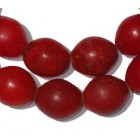
Looking at this strand of Tomato Beads, it’s hard to believe they’re over a hundred years old. With their smooth oval shape and vibrant color, these stunning antique Trade Beads appear almost brand new! But, their seamless beauty is in part due to their origin. Tomato Beads were first produced in Murano, Italy at the turn of the 19th Century, during a time when industrial development was evolving many a traditional art-form.
These large, translucent beads were created by densely winding glass around a mandrel whilst hot. Each bead would then be rolled upon a flat metal sheet to achieve the spherical oval shape, and the ends ground down to eliminate winding marks. Their name derives from the limited number of colors in which they were produced – usually red, yellow and orange. Venetian Tomato Beads tend to be larger than other ‘plain’ trade beads as they were used as both ballast for ships, and as a form of currency for trade among tribes in Africa. They were predominantly traded in Ethiopia from the 1830s, however, strings have also been found in parts of West Africa.
The modern appeal of Tomato Beads may be obvious to budding collectors, but if you’re a jewelry designer, these antique Venetian Trade Beads can also add significant value to your creations. Strings are rarely cheap, with prices in the region of $40-$200, and many people are now buying pieces of jewelry due to the value of single beads alone. If you are thinking about purchasing a strand, look for strings that have typical signs of general wear, such as inclusions, as these tend to be old and extremely valuable.